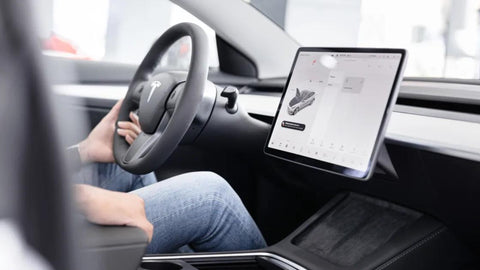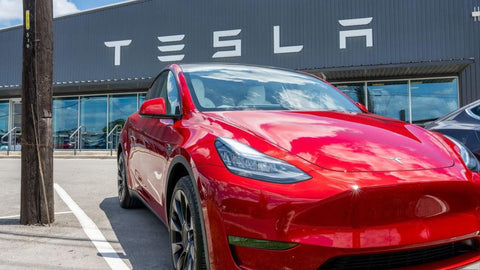That scream is too loud! Tracking Down and addressing Tesla Brake Noise
Tesla uses a regenerative braking system that recovers energy during deceleration, unlike conventional gasoline-powered vehicles that depend mostly on friction brakes. But even Tesla's have regular brakes in case the electric motor fails, and those can be noisy in some situations.

The cutting-edge electric vehicles made by Tesla are known for providing an incredibly peaceful and futuristic ride. While most Tesla's don't make any audible engine noise, certain drivers may occasionally hear an unwanted sound: brake noise. Brake noise, whether it's a Tesla Model 3 brake grinding noise
, squeaking, or screeching, is unsettling.
You shouldn't freak out if you hear an annoying braking sound when driving your Tesla. Let's figure out what's going on and where it's coming from. This article will discuss the most typical reasons why Tesla automobiles make braking noise and offer solutions that you can actually implement.
Exploring The Braking Mechanism Of Tesla, Diagnosing Tesla Brake Noise:
When the vehicle brakes, its principal system, regenerative braking, transfers some of the kinetic energy to electrical energy, which is then sent back to the battery. Quiet and effective, this is.
The conventional friction brakes come on when the battery gets full or when the brake pressure is increased, serving as a backup system.

How To Recognize Brake Sounds:
Make sure you know exactly what kind of braking noise you're hearing before you try to fix it. The possible origins of the following common braking noises are:
When you lightly apply the brakes, you can hear a high-pitched screeching sound that could be an indication of worn brake pads or brake dust on the rotors.
When pressing down on the brake pedal or when braking, you might hear a squeaking sound. Brake pad vibrations or a lack of lubricant on the parts of the brake system could be to blame.
The sound of metal rubbing on metal, as in a grinding or scraping noise, is often an indication of brake components that are excessively worn or broken.
Reasons Why Tesla Brakes Make A Noisy Sound:
Troubleshooting Tesla brake noise:
- Debris Accumulation: Grinding or scraping sounds could be produced when dirt, stones, or other debris becomes stuck between the brake pad and the rotor.
- The brake pads on your vehicle will eventually wear down and start making a screeching noise when it's time to replace them.
- The accumulation of moisture on the rotors, which can happen after a car wash or when driving in rainy weather, can cause corrosion and the subsequent scraping sound.
- An uneven wear pattern on the brake pads might lead to a grinding or chattering noise.
Dealing With Distractions:
Visual Check: Give your wheels a quick glance. Be cautious as you search for and remove any debris that may be stuck around the brakes.

You can see how your Tesla's brake pads are doing by checking the app on your mobile device. Verify if you have received any service alerts.
Make an Appointment for Service: If the noise continues or you see any uneven or worn brake pads, it's recommended to contact Tesla for assistance. Their knowledge and equipment allow them to assess the situation and make the required repairs.
Quieting The Cranks:
Maintenance: Make sure to schedule frequent service appointments for your brakes. This will allow us to inspect them and catch any potential concerns early on.
Reducing wear and tear on the brake pads is possible through the practice of regulated and smooth braking.
When you can, park your Tesla in a dry area with winter tires to keep the rotors from becoming too wet.
Resolving Brake Hull Noise:
Finding out what kind of braking noise it is will allow you to fix it properly. The following is a list of frequent problems with braking noise in Tesla vehicles and how to fix them:
- Check Brake Pads and Rotors: First, look for damage or wear on the brake pads and rotors. It may be necessary to replace the brake pads or rotors if they seem thin or if there are indications of scoring or uneven wear.
- Remove Debris and Brake Dust From Brake Components: Debris and brake dust accumulation on brake rotors and pads can occasionally create brake noise. To clean the brake components and remove any dirt that has accumulated, use compressed air or a brake cleaner.
- If the brake caliper pins aren't well-lubricated, the brake pads could stick and make a screeching sound. The caliper pins should be coated with high-temperature brake oil to make sure the brake pads glide smoothly.
- Keep an eye out for software updates and technical service bulletins (TSBs). From time to time, Tesla will release TSBs to fix known faults, such as braking noise. For information on any applicable TSBs or software updates for your car, visit Tesla's official website or get in touch with customer service.
If you're still having trouble after trying to figure out what's making the noise, it may be time to take your vehicle to an authorized Tesla service center for an assessment and possible repair. The problem can be precisely diagnosed and fixed or replaced by qualified technicians.
Keep Your Vehicle In Top Condition:
In addition to fixing the problem with the current braking noise, implementing maintenance procedures can assist keep the problem at bay. To ensure that your Tesla's brakes remain in pristine condition, consider the following:

Schedule routine brake inspections for your Tesla to identify problems early and stop them from wearing out too quickly.
Brake Gently: To keep brake pad wear and noise to a minimum, brake gently whenever possible.
Always adhere to Tesla's recommended maintenance schedule: To keep your Tesla's braking system in top shape and extend its life, be sure to check it often and replace worn parts as directed.
Understanding Tesla Vehicle Systems And Alerts
In Tesla vehicles, the steering wheel serves as the primary interface for control, facilitating smooth maneuvering on the road. Alongside normal operating sounds, such as the gentle hum of the electric motor, drivers may also encounter mechanical noises associated with the activation of disc brakes or parking brakes. Regular maintenance checks, including monitoring brake fluid levels, ensure the optimal functioning of these critical components. The pedestrian warning system alerts drivers when pedestrians are nearby, prompting them to engage their mechanical brakes for added safety at the crosswalk.
Moreover, Tesla's advanced safety features, like emergency braking and pedestrian warning systems, enhance driver awareness and responsiveness on the road. Additionally, lane departure warning alerts provide timely notifications to help drivers stay within their lane, promoting safe and attentive driving habits. By familiarizing themselves with these systems and alerts, Tesla drivers can ensure a secure and enjoyable driving experience.
Braking Systems
Braking Systems: Regenerative braking and conventional friction brakes are used in tandem by Tesla automobiles. Friction brakes are utilized for additional stopping power or when the battery is full, whereas regenerative braking uses the electric motor to slow down and recover energy from the vehicle.
Dynamic Brake Lights (if equipped)
If installed, certain Tesla models may have dynamic brake lights that flash quickly to alert oncoming cars when you use severe braking.
To Set The Regenerative Braking Level
To Modify the Regenerative Braking Level: The menu system in a Tesla vehicle can be used to modify the degree of low speed of regenerative braking. This may have an impact on how quickly the vehicle decelerates when you take your foot off the accelerator.
Stopping Mode
Different stopping modes are available on some Tesla models, and these can have an impact on how the vehicle responds to braking. For instance, the "Creep" mode enables the car to roll slowly at low speeds, while the "Hold" option allows you to completely stop the vehicle without using the brake pedal.
Conclusion
To sum up, brake noise can occasionally ruin your Tesla driving experience, but it's typically fixable with the correct method. Your Tesla can return to its previous level of smooth, noiseless braking when you correctly identify the sort of noise it is making and apply the correct solutions. Always prioritize safety by bringing your vehicle to an authorized Tesla service shop if you are unsure how to fix the brake noise on your own.
 :
:  :
: 



















